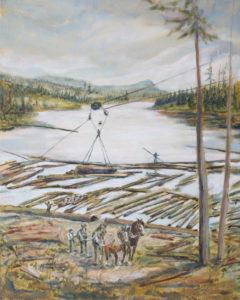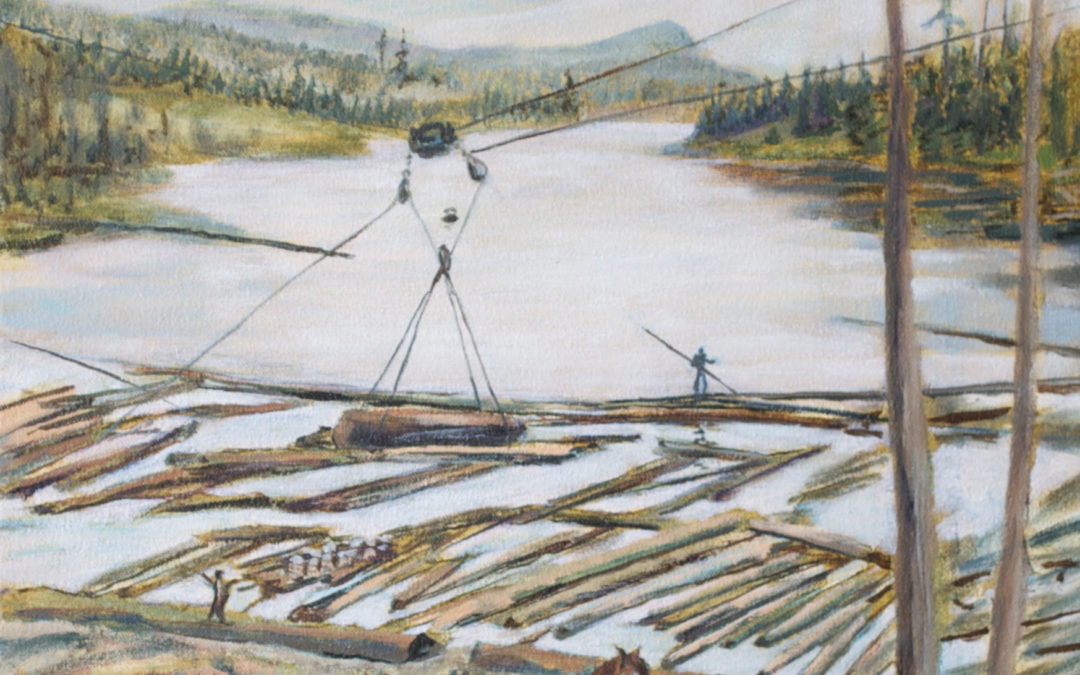Ursula Medley is a fourth-generation artist. She was born in Bogota, Colombia and immigrated to Vancouver in 1950. She settled in Powell River in 2001.
An art educator and art activist with a passion for creating community through art, Ursula is a prolific painter inspired by observing wilderness, weather, people and animals. She recently produced a series about logging machinery and equipment – historical and contemporary.
Why did you decide to paint this series about the coastal forest sector?
Ursula • From where I live in Lang Bay I often watch log barges heading down the Malaspina Strait. My curiosity to the whereabouts of their destination led me to visit Stillwater Log Sort.
From the parking lot on that particular day the light on log booms, the log crane, the log sort inspired me to return to the studio to start work on this series. With the help of Nikita Johnston, Collections Manager at Powell River Historical Museum, I found images of early logging days at Stillwater. Landscape painting has been one of my genres.
Incorporating images of historical reference to logging in the landscape offers a narrative to the paintings and speaks to Powell River’s history based largely on the logging industry.
What is your connection to the forest industry?
Ursula • I use forest products every day, heat my house with wood, get access to the back country via logging roads, my house is made of wood, my hardwood floor is local maple milled in Powell River by Theden Forest Products.
In 1977 I tree planted a section for MacMillan Bloedel on Galiano Island.
Although I participated in protests against clearcut logging at Clayoquot Sound I acknowledge that the forestry industry is a source of employment for many, that forests are a renewable resource. I appreciate the attention given to the importance of selective logging. My hope is that old growth trees be protected.
My daughter Jean Medley has a BSc in Forest Operations from UBC. My father Paul Binkert spearheaded much of the trail building and maintenance in the mountains around Vancouver including trails to Williamson Lake, the Lions, the Squamish Chief, Singing Pass, Wedgemount Lake, and North Creek.
What is your connection to the forest?
Ursula • My emotional and physical wellbeing benefit from walking in the forest and breathing the forest air. I often paint en plein air.
In 1997 I painted a series of egg tempera paintings depicting the old growth trees in Stanley Park and in Cypress Provincial Park as icons. The collection was exhibited in Venice, Italy.
Why do you think art about industry is so rare?
Ursula • I think most people prefer to look at an image that doesn’t remind them of work.
Historically western painting was primarily focused on religious paintings as the Church was the main patron for painters. Gradually as trade and colonization by Europeans became a source of wealth, private patrons commissioned artists to paint portraits of themselves and their families for prestige.
The industrial revolution provided artists with industrial subjects.
A couple of my favorite contemporary painters using industry as their subject include Italian painter, Alessandro Papetti.
Closer to home we see industry as an influence in the work of Vancouver painter and sculptor Marcus Bowcott.









Very very important work. So proud of Ursula….